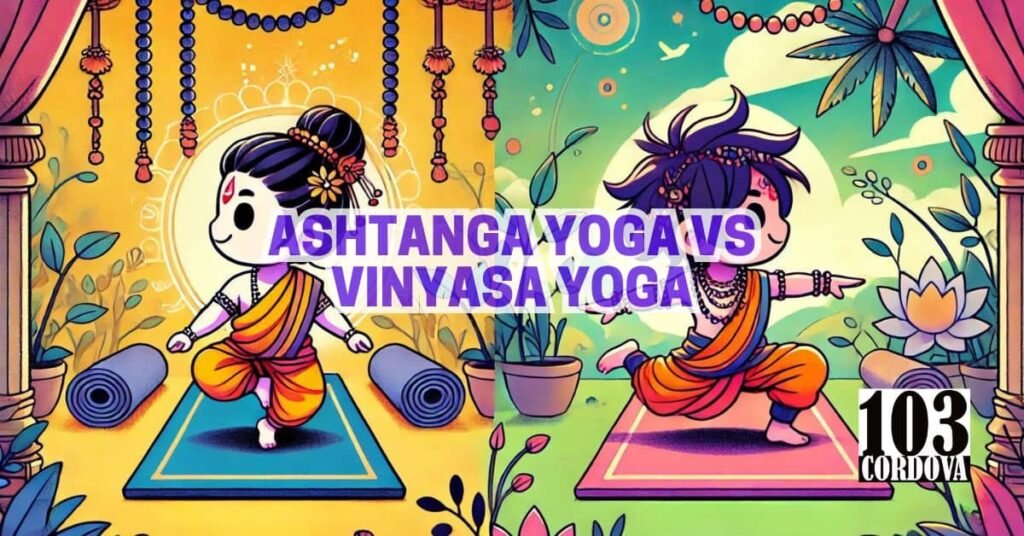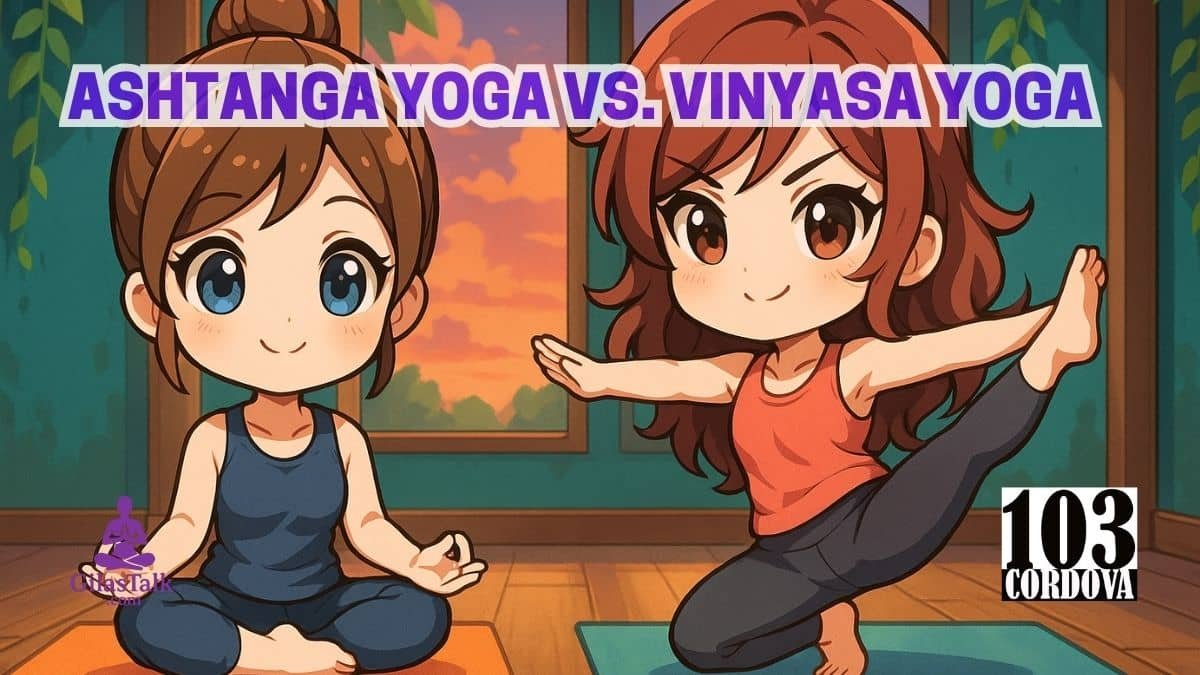Ashtanga Yoga vs. Vinyasa Yoga is a common comparison for people exploring different approaches to movement and breath.
Both are active forms of yoga that connect postures with breathing, yet they offer very different experiences.
Ashtanga Yoga follows a set sequence of poses practiced in the same order, while Vinyasa Yoga changes from class to class depending on the teacher.
These differences affect not only the physical challenge but also the mental focus and style of learning.
Understanding how each practice works will help you decide which path best supports your goals and lifestyle.
1. What are Ashtanga Yoga and Vinyasa Yoga? Understanding the Basics
Ashtanga Yoga is a system that follows a strict set of sequences, moving step by step from one series to the next as the practitioner gains mastery.
Each series is made up of a specific group of asanas that are always performed in the same order, creating a sense of discipline and structure.
A well-known part of an ashtanga practice is the sun salutation, which is repeated at the start of each session to build heat and prepare the body.
This approach shows one clear difference between Ashtanga and Vinyasa because Vinyasa Yoga does not follow a fixed sequence.
Instead, a teacher can design a flow that combines asana in many different ways, often adapting to the needs or level of the students in the room.
These flows may also draw from hatha yoga, the broader tradition that gave rise to both modern styles.
Since no two Vinyasa classes are alike, students experience variety and creativity that keep the practice fresh.
Ashtanga, by contrast, gives students a chance to deepen familiar asanas over time and gain confidence through repetition.
Both styles focus on connecting breath and movement, but the way they organize and present the practice creates very different experiences.
🧘 Why Chair Yoga Training Is Essential for Office Workers
2. Core Principles: How Ashtanga and Vinyasa Yoga Differ
Ashtanga Yoga is grounded in tradition, with a rigid set of six series that must be practiced in order, requiring patience and discipline to advance.
The focus is on mastery through repetition, with practitioners spending years on a single series before moving on.
Vinyasa Yoga, by contrast, emphasizes creativity and flexibility, allowing instructors to design sequences based on the needs of the class.
The goal of Vinyasa is to create a smooth flow from one pose to another, with less emphasis on rigid progression.
This fundamental difference defines the contrasting nature of these practices: structure versus adaptability.
🧘 Why Somatic Yoga Training is a Game Changer for Stress Relief
3. Practice Structure: The Fixed Sequence of Ashtanga Vs the Flow of Vinyasa
The practice structure of Ashtanga Yoga is highly regimented, with students repeating the same sequence of postures in every Ashtanga class.
This strict order builds discipline and allows practitioners to track progress in a clear and steady way.
The repetition also helps people memorize the sequence so they can practice yoga without depending on constant instruction.
Many yoga studios that offer Ashtanga emphasize this routine, giving students a consistent environment where they know exactly what to expect.
Vinyasa Yoga, on the other hand, offers variety because each class can be designed around a theme, a focus area, or even a peak pose.
This variety keeps practitioners attentive and curious since they never know exactly how the class will unfold.
The fluid nature of Vinyasa also gives teachers the freedom to adjust to the energy and needs of the group on any given day.
While Ashtanga’s fixed structure supports gradual mastery through repetition, Vinyasa’s flexible approach encourages constant growth and adaptation in both body and mind.
🧘 Can Heated Vinyasa Yoga Help You Lose Weight Effectively?
4. Breathing Techniques: Ujjayi Breath in Ashtanga Vs. Breath Synchronization in Vinyasa
In Ashtanga Yoga, Ujjayi breathing is a cornerstone of the practice.
This specific technique involves controlling the breath by gently constricting the throat, creating a rhythmic and audible sound that aids concentration.
The breath is synchronized with each movement, helping practitioners stay present and focused throughout the challenging sequences.
Vinyasa Yoga also incorporates Ujjayi breathing, but the emphasis is more on matching breath to the dynamic flow of poses.
While both styles use breath to link movement, Ashtanga’s focus is on maintaining a consistent breath throughout a structured sequence, while Vinyasa integrates breath more fluidly within ever-changing flows.
🧘 How to Learn Aerial Yoga Poses Names for a Better Practice

5. Focus in Practice: Tristhāna in Ashtanga and Cueing in Vinyasa
In Ashtanga Yoga, focus is guided by Tristhāna, which combines breath, internal locks called bandhas, and fixed gaze points known as drishti.
The bandhas, such as Mula Bandha at the pelvic floor and Uddiyana Bandha in the lower belly, are used to build strength and control energy.
Drishti, or steady gazing at specific points, helps reduce distractions and improve concentration.
Vinyasa Yoga may include some of these elements, but usually gives more attention to posture alignment, smooth transitions, and the theme of the class.
This difference shows how Ashtanga builds inward focus while Vinyasa highlights outer flow and adaptability.
🧘 Exploring the Benefits of Meditation and Yoga
6. Physical Benefits: Strength and Flexibility from Ashtanga Vs. Overall Fitness from Vinyasa
Ashtanga Yoga builds physical strength and flexibility through its demanding and repetitive sequences, which include challenging postures like arm balances and deep stretches.
Practitioners progress gradually, often holding poses for longer periods, leading to increased endurance and muscular development.
Vinyasa Yoga, with its varying intensity and diverse range of movements, offers a broader approach to overall fitness, including cardiovascular health, balance, and coordination.
While Ashtanga focuses on deepening strength and flexibility through repetition, Vinyasa’s changing sequences allow for a more comprehensive workout that can target different areas of the body in each class.
Both styles contribute to physical health, but the paths they take differ significantly.
🧘 Surprising Benefits of Yoga for Health You Need to Know
7. Mental and Emotional Benefits: Focus and Discipline in Ashtanga Vs. Stress Relief and Mindfulness in Vinyasa
Ashtanga Yoga cultivates mental discipline through its structured, repetitive nature, requiring consistent focus to master each series.
This repetition builds concentration and patience, which can translate into daily life.
Vinyasa Yoga, with its emphasis on flowing movement and breath, promotes stress relief and mindfulness, allowing practitioners to release tension and be present in the moment.
The mental benefits of Ashtanga arise from its strict discipline, fostering resilience and mental endurance, while Vinyasa’s benefits come from its ability to encourage relaxation and reduce stress.
Both styles offer emotional well-being, but they serve different aspects of mental health.
🧘 How the Benefits of Daily Yoga Can Transform Your Life
8. Intensity and Difficulty: Comparing the Rigorous Ashtanga Practice with the Variable Vinyasa Flow
Ashtanga Yoga is known for its rigorous, high-intensity sequences that demand physical endurance and commitment.
The practice becomes progressively more challenging as practitioners advance through the series, making it a demanding choice for those seeking a disciplined routine.
Vinyasa Yoga, on the other hand, offers flexibility in intensity, allowing classes to range from gentle and restorative to physically demanding, depending on the teacher’s approach.
This adaptability makes Vinyasa accessible to a wider audience, from beginners to experienced yogis.
While Ashtanga is consistently intense, Vinyasa provides a more varied and adjustable experience depending on personal preferences and class styles.
🧘 Why Bear Pose Yoga Is Essential for Building Core Strength and Stability
9. Class Environment: Traditional Mysore Style of Ashtanga Vs. Dynamic Vinyasa Classes
Ashtanga Yoga is often practiced in a Mysore-style setting, where students work through the set series at their own pace with guidance from a teacher.
In this environment, the instructor offers personalized adjustments and advice as practitioners progress through the postures, creating a highly individualized experience.
Vinyasa Yoga, in contrast, typically takes place in a group class where the teacher leads everyone through the same sequence in real time.
This creates a dynamic and often energetic atmosphere, with a focus on shared practice and group flow.
While Mysore classes foster independence and personal growth, Vinyasa classes provide a more collective, instructor-led experience.
🧘 The Holistic Benefits Of Ashtanga Yoga: Physical, Mental, and Beyond
10. Which Practice is Right for You? Beginner to Advanced Suitability for Ashtanga and Vinyasa
Ashtanga Yoga, with its strict structure and progressive difficulty, is often more suitable for those seeking a long-term commitment and a desire for discipline in their practice.
Beginners may find Ashtanga challenging but rewarding if they are ready to invest time and effort into learning the sequences.
Vinyasa Yoga, on the other hand, is more adaptable for all levels, making it an ideal choice for beginners or those looking for variety and creativity in their practice.
Vinyasa can be modified for both beginners and advanced practitioners, offering a flexible approach to growth.
Whether you prefer a structured progression or a more open, evolving practice depends on your individual needs and goals.
🧘 Long-Term Health Benefits of Ashtanga Vinyasa Yoga for Aging Well
11. Combining Ashtanga and Vinyasa: How to Benefit from Both Yoga Styles
Many practitioners choose to blend Ashtanga and Vinyasa to enjoy the benefits of both approaches.
Ashtanga’s structured practice builds discipline, strength, and endurance, providing a solid foundation for any yoga practice.
Vinyasa complements this by adding creativity and fluidity, allowing practitioners to explore different movements and prevent monotony.
Combining both styles can offer a balance between rigorous discipline and freedom, helping practitioners grow in strength, flexibility, and mental focus.
By integrating these practices, you can experience the best of both worlds and enjoy a well-rounded yoga journey.
💡 Conclusion
Ashtanga Yoga and Vinyasa Yoga each provide unique paths to physical, mental, and emotional well-being.
Ashtanga’s fixed sequences and disciplined approach are ideal for those seeking structure and gradual mastery over time.
Vinyasa’s flexibility and ever-changing flows appeal to individuals who enjoy variety and adaptability in their practice.
Deciding between the two depends on your personal preferences, goals, and how you like to approach your yoga practice.
Both styles offer valuable benefits, and understanding their differences can help you choose the right practice or even integrate both into your routine.
🤝 Our Friends’ Services
Looking for yoga classes that cater to all ages and skill levels?
Join us at 103 Cordova Tower, Marquinton Residences, Cirma Street, Sto. Nino, Marikina City, where we offer personalized yoga sessions designed to enhance your physical and mental well-being.
Whether you’re a beginner or an experienced yogi, our skilled instructors create a welcoming environment for everyone.
For more details, reach us at 09176225780, via Facebook, or through our website’s contact form.
Start your journey to a healthier and more balanced lifestyle with us today!
❓ FAQs
1. Which style is better for weight loss?
Both Ashtanga and Vinyasa yoga can contribute to weight loss, but they do so in different ways.
Ashtanga’s rigorous, repetitive sequences and high-intensity nature can lead to a significant calorie burn and build lean muscle, which boosts metabolism.
Vinyasa’s varied flows can also be physically demanding, offering a great cardiovascular workout that burns calories.
Ultimately, consistency in practice and a balanced diet are the most important factors for weight loss, regardless of the style you choose.
2. Can I practice Ashtanga at home without a teacher?
While it is possible to practice Ashtanga at home, it is highly recommended that beginners learn the Primary Series from a qualified teacher first.
The fixed sequence and specific alignment of poses are crucial for building a strong and safe practice.
A teacher can provide hands-on adjustments, help you understand the foundational principles like Tristhāna, and ensure you are performing postures correctly to prevent injury.
Once you have a solid understanding of the sequence, a home practice can be a very effective way to deepen your discipline.
3. Is Vinyasa yoga safe for people with injuries?
Vinyasa yoga can be a good option for individuals with minor injuries due to its adaptable nature.
Because the teacher creates the sequence, they can often offer modifications to postures to accommodate different needs.
However, it is essential to inform your instructor about any injuries before class begins.
For more serious injuries, it is always best to consult with a doctor or physical therapist and choose a gentler, more therapeutic style of yoga to avoid further harm.
4. How long does a typical class last for each style?
The length of a yoga class can vary depending on the studio and instructor.
A full Ashtanga Primary Series class typically takes around 90 minutes to complete.
In a traditional Mysore-style setting, you might spend the same amount of time but work at your own pace through the sequence.
Vinyasa classes, on the other hand, offer more flexibility and can range from a quick 45-minute session to a full 60- or 75-minute class, with some specialized workshops lasting even longer.
5. Do I need any special equipment for either style?
For both Ashtanga and Vinyasa yoga, the only essential equipment you’ll need is a good yoga mat to provide grip and cushioning.
While not required, some practitioners may choose to use props like yoga blocks or a strap, especially in Vinyasa classes where teachers might use them to aid in certain poses or modifications.
Generally, most studios provide these props for students, so you can often start your practice with just a mat.

